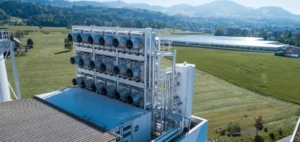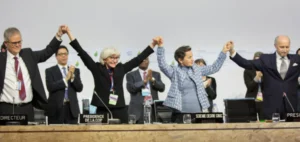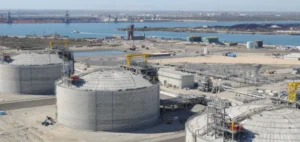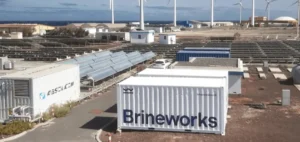The United Nations Framework Convention on Climate Change (UNFCCC) confirms the first methodology of the Paris Agreement Crediting Mechanism (PACM) dedicated to landfill gas. The Article 6.4 Supervisory Body (SB) sets eligibility conditions for capturing, flaring, or utilizing methane extracted from solid waste disposal sites. The methodology specifies emission baselines, calculation parameters, and monitoring requirements to convert measured reductions into transferable units. The arrangement combines centralized registry governance with third-party verification for issuance and traceability.
Methodological scope and technical boundary
The methodology targets activities within the perimeter of solid waste disposal sites with three technical routes: flaring, electricity or heat generation, and supply for energy uses. The rules govern delineation of sources, accounting for leaks, and allocation of benefits when the gas is used as an energy input. The text introduces a baseline construction designed to limit the gap between common practice and the project scenario across heterogeneous contexts. The calculation parameters separately identify contributions from avoided methane and any energy co-products.
The methodological sequence integrates common tools to standardize assumptions and measurements. The tools cover quantification of emissions from landfills, measurement of the mass flow of a greenhouse gas in a gaseous stream, and assessment of emissions related to flaring. The package frames data requirements, metrological control, and quality assurance needed for independent verification. The methodology remains compatible with a future update of grid emission factors to harmonize electricity valorization cases.
Measurement, reporting, and verification (MRV)
Monitoring, Reporting and Verification (MRV) imposes measurement series, target uncertainties, and calibration procedures for sensors and meters. The modalities require comprehensive technical documentation, including measurement plans, performance checks, and data management. Third-party verifications rely on instrumental evidence, site audits, and consistency tests to validate uncertainty reductions. Results are aggregated under a calculation protocol that enables conversion into standardized units.
The MRV framework addresses flare quality and operating conditions that affect methane destruction. Protocols cover service continuity and outage management to reflect volumes actually treated. Transparency of assumptions and emission factors is required to ensure comparability across projects. Traceability of adjustments and corrections is a mandatory component of the files submitted for verification.
Additionality, investment, and common practice
An investment-based additionality test is required to demonstrate that the project depends on revenues from credited units. Developers must present a financial analysis documenting scenarios, costs, revenues, and sensitivities, with consideration of local conditions. The common-practice analysis aims to exclude configurations already adopted at scale without carbon incentives. This dual filter limits registration to activities whose viability relies on the mechanism and reduces the risk of attributing units to usual actions.
The additionality requirement is articulated with technical obligations to avoid locking in lower-performing options when valorization routes are available. Cases combining upgrading to biomethane and grid injection must integrate compatible grid parameters when emission factors are revised. Financial and technical filings must remain consistent over the crediting horizon. Controls include updating assumptions when operational changes affect cost or revenue structures.
Governance, registry, and international transfers
Units are issued in the Article 6.4 Registry after validation and verification by an accredited Designated Operational Entity (DOE). Cross-border transfers require a Letter of Authorization (LOA) and a corresponding adjustment to prevent double counting against the host country’s Nationally Determined Contribution (NDC). The central registry records unit serial numbers, account holders, and movements to ensure uniqueness. Mechanism reports define the respective responsibilities of host countries and buyers for documentary compliance.
The arrangement includes cross-cutting risk-management elements to maintain the integrity of the unit stock over time. Decisions on reversal management provide for mutualized buffers and third-party guarantees where relevant. Guidance frames prevention of integrity losses and associated remediation plans. Actors must incorporate these requirements into purchase and financing documents.
Market, prices, and contracts
Transitioning under the UN mechanism structures a potential supply of landfill-gas reductions in a standardized format. Effective volumes will depend on the compliance of existing and new projects with additionality and measurement requirements. Professional buyers will prioritize units accompanied by authorizations and corresponding adjustments to secure international use. Observed price spreads on voluntary markets suggest differentiation based on procedural quality and data robustness.
Emission Reduction Purchase Agreements (ERPA) must integrate clauses specific to the mechanism. Conditions precedent cover receipt of host-country authorizations, independent verification, and issuance in the registry. Adjustment clauses address baseline revisions, measurement gaps, and regulatory changes. Technical annexes set data formats, audits, and liabilities in case of non-compliance.
Methodological sequence and workplan
Starting with landfill methane is explained by the availability of field data, maturity of capture practices, and direct measurability of flows. The roadmap prioritizes publication of foundational tools for grid parameters to prepare a dedicated renewable-energy methodology. Complementary standards for measurement and governance are scheduled to consolidate coherence across project families. Stability of common parameters should facilitate extension to other sectors under the same issuance and monitoring framework.
National authorities are expected to publish authorization procedures and to articulate them with domestic objectives. Waste operators need to plan upgrades of capture systems and reporting to meet instrumental requirements. Institutional buyers are organizing procurement policies around traceability, corresponding adjustments, and issuance timelines. The combination of these elements will condition unit liquidity and the bankability of registered projects.






















